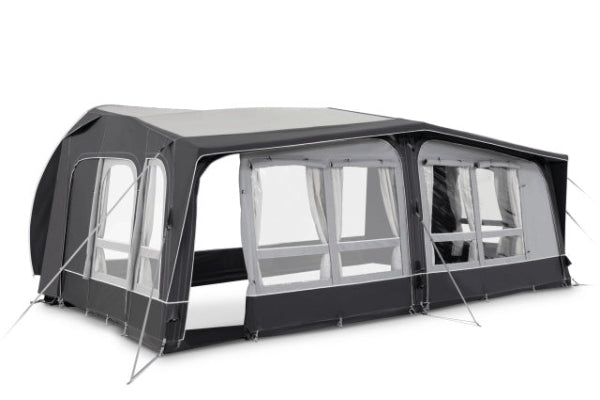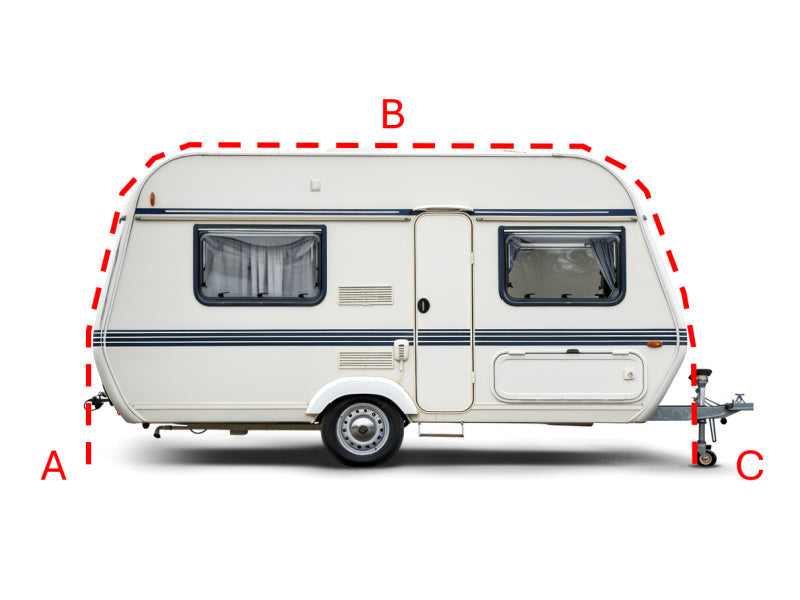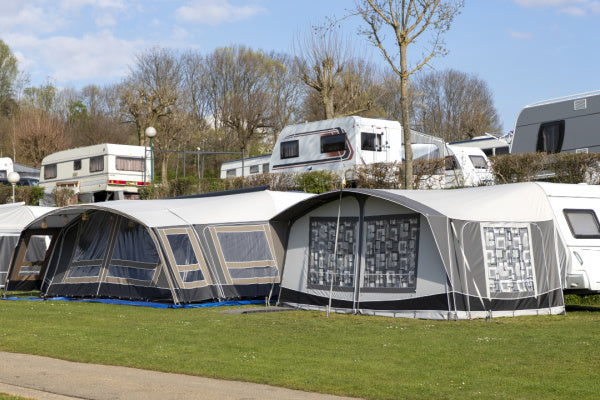How to Pack Away a Caravan Awning the Right Way
Soggy, crumpled caravan awnings are a camper's nightmare. Save yours from this fate! Pack it away properly by removing pegs and guy ropes, folding according to type, and storing in a dry place. These simple steps will protect your investment and ensure clear skies on your next adventure.

Preparing for Takedown
The secret to a smooth awning takedown lies in the preparation. Smart preparation prevents common frustrations and helps avoid those dreaded fabric tears.
Checking Weather Conditions
Timing matters more than most people realise. The ideal conditions for packing away an awning are sunny with light winds.
Strong winds can turn an awning into a troublesome sail, making the job needlessly difficult. Rain isn't just uncomfortable to work in - it forces you to store a damp awning, which invites mould and mildew to take hold.
Watch the forecast closely. Plan your takedown for the driest part of the day, ideally when the morning dew has evaporated but before any afternoon winds pick up.
If unexpected rain catches you out, set aside time to dry the awning thoroughly before final packing. A damp awning in storage is asking for trouble.
Removing Loose Items
Start with a proper clear-out of the awning space. Even small items left behind can cause problems during folding.
Remove all camping furniture, storage boxes, and equipment. Check thoroughly for forgotten items like tent pegs, guy rope toggles, or small camping gadgets that might have been overlooked.
Pay special attention to sharp objects that could tear the fabric. Even something as innocent as a forgotten bottle cap could cause damage during storage.

Unpegging and Lowering the Awning
This step requires patience and method. rushing the unpegging process often leads to tears and snags.
Start at the corners and work systematically around the awning. Keep track of all pegs and guys - a dedicated storage bag helps prevent future hunts for missing pieces.
Loosen guy ropes gradually. Sudden slack can cause the awning to shift unexpectedly, putting stress on the fabric and fixtures.
Work with a partner if possible. Having someone steady the awning while removing supports makes the whole process smoother and safer.
Folding and Rolling the Awning
The folding stage often determines how well the awning will store and perform next season. Take time to get this right.
Following Manufacturer's Instructions
Different awning designs need different approaches. Some roll, others fold, and many combine both methods.
Check the manufacturer's guide for specific folding patterns. These aren't just suggestions - they're designed to protect seams and maintain the awning's shape.
Modern awnings often have marks or guidelines showing the correct folding lines. Using these helps prevent stress on the fabric and keeps everything properly aligned.
For pole-and-sleeve designs, remove poles carefully to avoid snagging. Label them if needed - it makes next season's setup much easier.

Avoiding Creases and Damage
Careful folding prevents permanent creases that can weaken the fabric over time.
Brush off any dirt or debris as you fold. Even tiny particles can work their way into the fabric during storage, causing wear or staining.
Keep folds loose rather than tight to prevent sharp creases. Think gentle curves rather than sharp angles.
Watch for catching or snagging, especially around windows and door panels. These areas need extra attention during folding.
Storing Your Awning
Storage conditions can make or break an awning's longevity. The right environment prevents unnecessary wear and extends its life significantly.
Choosing a Dry and Ventilated Space
The ideal storage space stays dry year-round and maintains a fairly stable temperature.
Avoid uninsulated garages or sheds where temperature and humidity fluctuate wildly. These conditions stress the fabric and can lead to degradation.
Check storage areas for potential water ingress points. Even small leaks can cause big problems over a winter of storage.
Good ventilation helps prevent musty odours and discourages mould growth. Air movement is your ally in long-term storage.
Using a Storage Bag
The right storage bag provides essential protection during the off-season.
Choose a bag designed for awnings - they include features like ventilation and reinforced corners. Avoid plastic bags that can trap moisture.
Clean the storage bag before use. Old dirt or debris inside the bag can transfer to the awning during storage.
Store poles and pegs separately to prevent punctures. Use dedicated pole bags or tubes if available.
Pack the awning loosely in its bag. Cramming it too tightly can create permanent creases and stress points.
Remember to store the bag off the ground, ideally on a shelf or rack. This extra precaution protects against dampness and unwanted pests.
By following these detailed steps, your awning should emerge from storage ready for another season of adventures. The extra time spent on proper packing and storage pays off in durability and reliability when you need it most.
Regular checks during the storage period help catch any issues early. A quick monthly inspection can prevent unwanted surprises when camping season returns.
Keep your awning's manual handy for reference. Manufacturers often include specific care instructions that help maintain warranty coverage and optimal performance.
Other content you might like:
- Caravan awning size guide and calculator
- How to open a caravan awning
- How to tension caravan awning
- Caravan awning setup guide
- Caravan awning layout ideas
- Caravan awning instructions manual
- Caravan awning essentials
- How to peg a caravan awning
- How to get an awning tight to a caravan
- How long does it take to put a caravan awning up?






Leave a comment